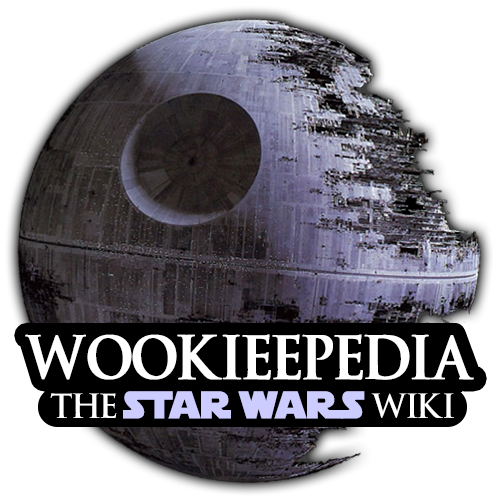
Star Wars Outlaws has released and spoilers from it will begin to appear on the wiki per our Spoilers policy. If making any edits concerning the game please be sure to add Template:Spoiler to the top of the page to warn others.
Don't have an account? Advertisement

"…the singular defining event of recent years—the unprecedented peace agreement between the Sith Empire and the Galactic Republic, the Treaty of Coruscant." ―Jedi Master Gnost-Dural — Listen (file info) [2]
The Treaty of Coruscant was an armistice and subsequent peace agreement that brought an end to the Great Galactic War in 3653 BBY. The Galactic Republic was strong armed into the treaty following the twenty-eight year conflict with the Sith Empire that saw the galactic government crumble under the pressures of war and economic struggles. In reality, the "treaty" functioned as more of an armistice, as, while peace technically existed between both governments, as the concept was more of a cessation of hostilities between the Republic and Empire. This armistice was first proposed by the Sith Dark Council, under the leadership of the Sith Emperor. Although wary of possible ulterior motives, the Republic's Galactic Senate accepted the offer out of desperation. The two governments organized a summit to take place on the Core World of Alderaan, where delegations from both factions would meet to deliberate the terms of peace.
While representatives of the Empire and the Republic conferred, the Empire launched an unexpected assault on the Republic capital world of Coruscant. The Sacking of Coruscant placed the Republic's capital firmly under the control of the Sith Empire, and gave the Imperial delegation on Alderaan the leverage they needed in order to demand the Republic's surrender of the war. The leader of the Imperial delegation—the Sith Lord Darth Baras—authored the Treaty of Coruscant and presented it to the representatives of the Senate and the Jedi Order for their signatures. They signed the document, ending the Great Galactic War and declaring the Sith Empire as the victor.
Furthermore, to ensure compliance with the various clauses of the agreement, the Empire assigned protocol droids to shadow high-racking individuals within the Republic to remind them of the harsh terms of the armistice while allowing the Republic a somewhat degree of independent under Imperial supervision. It also demanded that all Republic forces and Jedi withdraw from open conflict with the Empire and that the Senate cede a number of outlying worlds to it. Thus, ushering in a brief period where the Sith reigned unopposed over the galaxy.
The agreement was heavily opposed by certain interests within the Republic, including Jedi Master Dar'Nala, General Elin Garza of the Republic Military, and the Royal House of Alderaan. Such opposition to the treaty led to the initiation of a galactic Cold War fought between the Republic and Empire both directly and by proxy. The treaty was so significant that the Galactic Senate adopted the date of its signing as a new dating standard.
"These are Imperial Commandos. Your actions are in violation of the treaty. " ―SP-99 to Satele Shan, after her assault on Imperial troops [1]

The Treaty of Coruscant officially ended open hostilities between the Galactic Republic and the Sith Empire in the Great Galactic War and divided the galaxy between the two superpowers. [2] The treaty established deadlines by which Republic forces and members of the Jedi Order were required to withdraw from battles against the Sith. If these deadlines were not met, Imperial forces were authorized to engage those forces of the Republic which were in violation of the treaty. Harsh restrictions were even placed on Republic personnel who were acting in compliance with the treaty. For instance, all Republic vessels were required to announce their arrival to the airspace above a planet to Imperial authorities. [5] Furthermore, to ensure compliance with the various clauses of the document, the Empire included a provision that allowed them to assign protocol droids to shadow certain individuals within the Republic and remind them of the mandates of the Treaty of Coruscant. [1]
The peace agreement also dictated that the Republic revoke the membership of a number of outlying worlds, thereby denying them the protection benefits that came with a seat in the Galactic Senate. [1] Additionally, the Sith Dark Council also demanded that the Republic turn over seven star systems that were largely uninhabited and strategically unimportant. [6] Other than the cessation of open warfare, the treaty only benefited the Republic in that it called for an end to the Empire's assault and occupation of Coruscant, the capital of the Galactic Republic. Although only a small delegation of diplomats agreed to the Treaty, the agreement could only be overturned within the Republic by a vote in the Galactic Senate. [1]
"The Great Galactic War dragged on for decades. Thousands of Jedi and Sith were slain. Countless star systems were ravaged." ―Jedi Master Gnost-Dural — Listen (file info) [2]
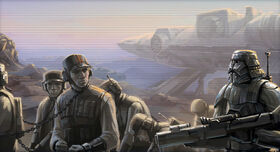
The Great Galactic War that engulfed the galaxy in conflict for nearly three decades began in 3681 BBY with the return of the self-exiled remnants of the ancient Sith Empire. These Sith were the surviving legacy of the ancient regime that had been defeated by the Galactic Republic and Jedi Order thousands of years prior in the Great Hyperspace War. [2] Led by the Dark Lord of the Sith known as the Sith Emperor, the Empire revealed itself to the Republic and immediately opened hostilities, sparking a galactic conflict. [7]
After capturing the Tingel Arm in a successful campaign early in the war, the Empire moved to secure the rest of the Outer Rim Territories. As world after world fell to the onslaught of the Sith, the Galactic Senate of the Republic was deadlocked on how to proceed with the defense of the galaxy. That slow response resulted in numerous victories for the Sith, including their seizure of the Aparo sector and their victory at Korriban. The Republic continued to suffer heavily as the Empire targeted key supply sources, such as the Sluis Van Shipyards, which were destroyed, and the Rimma Trade Route, which was blockaded. As the Senate worked to prioritize the Republic's defenses, many worlds were left wholly unprotected. The representatives of these planets blatantly refused to take part in further debate, instead choosing to leave the Senate to its crippling deliberations. [7]
The Empire secured the Outer Rim with the capture of the Seswenna sector in 3671 BBY and began plans to stab inwards towards the galactic core. However, after suffering dual defeats at Bothawui, the Sith were forced from the Mid Rim and put on the defensive. [8] The Republic's victories lasted a short time, however, as the Emperor changed strategies and put in motion a plan to secure the Mandalorians as allies in the war against the Republic. Imperial Intelligence agents sponsored the rise of a new Mandalorian leader [9] who would later become known as Mandalore the Lesser. [10] This Mandalore galvanized his people and led them to create a blockade of the Hydian Way—the Republic's primary trade route and means of transporting military wares. [11] The blockade crippled the Republic economy, [12] which had been in the grips of a downturn since the start of the war. [13] Although it was eventually broken by the Mirialan Hylo Visz and her band of smugglers, the blockade of the Hydian Way had already caused irreversible damage for the Republic. [12]
"I just can't shake the sense that there's something more to these peace talks than the Jedi Council is aware of…" ―Jedi Knight Satele Shan [1]

The conflict continued for several years with the Sith continually gaining more ground. Although they appeared to be on the verge of total victory, the Imperials suffered serious losses during the attempted conquest of the Core World of Alderaan and Darth Mekhis's efforts to secure Rhen Var. In response to those Republic victories, [6] as well as the loss of the Hydian Way, [12] the Imperials extended an offer of peace in 3653 BBY, [3] shocking the galaxy. The Dark Council of the Sith contacted the Galactic Senate and expressed its interest in ending the war, proposing that the two governments send delegations to represent the interests of their people in a peace conference on Alderaan. [2] In addition, the Empire began to downgrade the scale of its assault, ending their offensive in the Minos Cluster and scaling back operations on Dantooine. [1] The Republic was still hesitant to accept the offer and was advised to use caution when dealing with the Sith by the Jedi Council, but desperation eventually pushed the leaders of the Senate to agree to the proposal and make plans for the conference. [2]
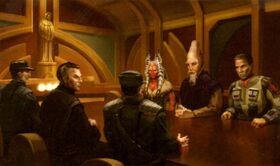
Despite their convincing facade of sincerity, the Sith were in fact using the conference as a distraction from their ultimate objective—the capture of the Republic's capital world, Coruscant. While Lords Angral, [1] Malgus, [14] and Adraas [3] prepared to lead the attack on the planet, Lord Baras led the Imperial peace delegation to Alderaan, where they met the Republic delegation led by the Cerean Senator Paran Am-Ris. The Senator was accompanied by two representatives of the Jedi Order, Jedi Master Dar'Nala and Jedi Knight Satele Shan. [1] As the parties began their negotiations, Angral, Malgus, and Adraas launched their attack on Coruscant. Malgus led the infiltration and destruction of the Jedi Temple [3] while Angral assaulted the Galactic City and assassinated Chancellor Berooken. [1]
Although the Empire's plans were nearly derailed when the Republic delegation on Alderaan witnessed the assassination of Chancellor Berooken via holotransmission, Lord Baras gained control of the situation by explaining to Am-Ris and the Jedi that the Sith were now fully in control of the Republic's capital, and that if the Empire's demands were not agreed to, Coruscant would be destroyed. Although Dar'Nala and Shan both argued against giving in to Imperial demands, Senator Am-Ris and Jedi Grand Master Zym agreed that they had to accept the Empire's terms if they wished to save Coruscant. The next day, Baras presented the Republic delegation with the Treaty of Coruscant, which the Sith Lord himself had authored. Senator Am-Ris signed the treaty, ending the war and placing the Empire firmly in the position of victor. [1]
"Thus began the unprecedented stalemate. The Jedi reconnecting with their roots, the Republic nursing its wounds, the Sith consolidating their power in a galaxy divided between darkness and light." ―Jedi Master Gnost-Dural — Listen (file info) [2]
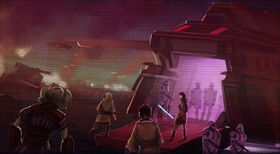
Pursuant to the mandates of the Treaty of Coruscant, the Republic and Empire ended open conflict. Control of Coruscant was handed back to the Republic, which was now being led by Paran Am-Ris as interim Supreme Chancellor. Republic military forces were gradually recalled from battlefronts across the galaxy, while Jedi were assigned to oversee the troop withdrawals. Two Jedi assigned to the task were Dar'Nala and Satele Shan, who were being watched over by the Imperial protocol droid SP-99. [1] Dar'Nala was radically opposed to the treaty, and nearly restarted the Great War by manipulating Republic and Sith agents in her quest to kill Lord Baras for creating the Treaty. The rogue Jedi Master gathered together a cabal of like-minded individuals within the Republic and Jedi Order, and together the group committed acts of terrorism throughout the galaxy. She orchestrated a skirmish in the Kuat sector, feigned her own death, and organized a bombing of the Senate Tower in order to kill politicians who supported the treaty. Dar'Nala's plot was ultimately foiled by Baras and Shan. After the death of the Togruta Jedi Master, her co-conspirators disbanded and much of the violence throughout the Republic subsided. [15]
Other early threats to the peace agreement included the Jedi Knight Aryn Leneer, who travelled to Coruscant while it was still occupied in an effort to avenge her Master, Ven Zallow. Zallow had been murdered in the Jedi Temple by Darth Malgus, who also ultimately came to be a threat to the Treaty's regime. The Sith Lord believed himself destined to destroy the Republic in its entirety, and saw the accords on Alderaan to be a perversion of the Empire's truest purpose—to make war. The Jedi Order avoided disaster with Leneer by disowning her before she was able to reach the planet; Malgus saw it as a betrayal not unlike the one he felt he had suffered at the hands of an Empire now focused on peace. As such, the Sith Lord defeated the Jedi but allowed her to go free. He later began a personal crusade against the Sith politicians who supported the Treaty of Coruscant [3] while simultaneously building his own power base in the Unknown Regions of the galaxy. [14]
Although they were still officially allied against the Republic, the Mandalorians and the Empire essentially ended their partnership when the treaty was signed. The Hutts meanwhile found the new political tension in the galaxy to be ideal conditions for the growth of their own interests and cartels. [16] During this unrest, leaders of both factions identified five major sectors that were vital to the balance of power between the Republic and the Empire: the Core Worlds, the distant Outer Rim, Hutt Space, the Unknown Regions, and the Seat of The Empire. [17]
"Everything I've seen on, on Hutta and Sebaddon, confirms my worst fears. Sebaddon is responding to the threat you all represent by ramping up production. It must be stopped before the contagion spreads. Since neither Empire nor Republic can single-handedly destroy this menace with the resources available right now, you must work together to see it done." ―Dao Stryver [16]
In the last years of the Great War, Imperial droid designer Lema Xandret was branded a traitor by the Sith and forced to flee the Empire after she protested her daughter's forced induction into the Sith Order. Xandret fled pursuit alongside a number of other discontent Imperial citizens, and together they formed a colony on the uninhabited planet Sebaddon, far above the galactic disc. Her colony grew in its technological abilities until around ten years after the signing of the Treaty of Coruscant. That year, Lema Xandret attempted to forge a partnership with the Mandalorians against the Empire, so as to eventually exact revenge against the Sith that had taken her daughter from her. Xandret sent Mandalore a small droid factory that could produce nearly invincible automatons as a sample of the powers at her command. After failing to hear from the warrior-king, Xandret dispatched the starship Cinzia to make contact, but the crew failed in its mission and the wreckage of the ship was collected by the Hutt-employed smuggler Jet Nebula. The droids that remained on Sebaddon, which were created to protect a clone of Lema Xandret's daughter, saw the attempt to contact outsiders as a threat to their mission. In response, the droids killed Xandret and the rest of the colonists and began replicating at a prolific speed, intending to one day to grow to such strength that they could eliminate everyone in the galaxy in order to protect Xandret's cloned daughter. [16]

Several weeks later, Imperial and Republic delegates were called to the independent world of Nal Hutta by the Hutt matriarch Tassaa Bareesh to partake in an auction of two items found in the wreckage from the Cinzia. The first was a navcomputer that would supposedly lead its owner back to the planet of the ship's origin. The second item was a mysterious container that was comprised of rare metals and an unidentified organic substance. Unbeknown to the auctioneers, the container was a droid factory created by Lema Xandret. To the Empire and Republic, the navcomputer represented a new, resource-rich world that could be annexed into their respective governments and added to each party's growing war machine. To the Jedi, the mysterious container was the priority: they believed it could be an artifact of great importance to the Order, or a weapon that had to be kept out of Sith hands. To the Sith, the navcomputer represented an opportunity to finally locate and punish Xandret for her transgressions fifteen years prior. Although Bareesh expected to conduct a clean and legitimate sale, both the Republic and Empire sent agents to ensure that they would be the auction's victor and obtain the items. [16]
The Empire was represented by Envoy Ia Nirvin, who was accompanied to Hutta by the Sith apprentice Eldon Ax, daughter of Lema Xandret. Ax was the pupil of Darth Chratis, who planned for Nirvin to partake in the auction while Ax broke into Tassaa Bareesh's vaults and stole the navcomputer. The Republic delegation to Hutta was lead by Envoy Ula Vii, a functionary serving under Supreme Commander Stantorrs who was in fact an Imperial Agent working covertly to further the goals of his Sith masters. Unknown to Vii, the Jedi had also sent an agent, Padawan Shigar Konshi, who was joined by former Republic trooper Larin Moxla. All of the participants in the auction were manipulated into participating through the actions of Dao Stryver, a Mandalorian who was working on behalf of the Mandalore to eliminate a threat growing on Sebaddon. While Ax attempted to steal the navcomputer, she was interrupted by Konshi, who had come to steal the container. The two were then beset upon by Stryver, who had also come for the navcomputer. The three battled in the vault anteroom before they were attacked by a squad of nearly invincible droids that were produced by Xandret's factory. The combatants destroyed the droids and fled the palace, leaving to hunt down the source of the factory. The Sith and the Jedi each independently learned the location of Sebaddon and rushed to reach and secure the world before their opponents could mobilize. Satele Shan—now the Jedi Grand Master—organized a task force to travel to Sebaddon and attempt to convince the colonists to join the Republic. The task force was quickly attacked by the uncooperative droids that were now running the world and suffered massive damage to their fleet when the planet launched thousands of the droids into orbit to combat the warships. During the fighting, Imperial forces under the command of Darth Chratis and Eldon Ax arrived to force the colonists to yield to the Empire's demands, but their fleet was also nearly destroyed. Both the Republic and Imperial forces were driven away from Sebaddon, forced to withdraw from proximity to the planet in order to avoid the droids that were forming orbital defenses. [16]
While both factions tried to formulate individual plans of attack, representatives from the two fleets were summoned to Sebaddon's moon by Dao Stryver, who had arrived prior to both the Republic and Empire. Before an audience consisting of Shan, Konshi, Moxla, Vii, Ax, and Jet Nebula, Stryver explained her findings regarding the Sebaddon colony and Lema Xandret's attempts to form an alliance with the Mandalorians. She further asserted that the droids' programming and ability to self-replicate posed a serious threat to the galaxy, as their numbers would soon become overwhelming. In a surprising show of cooperation, both parties at Stryver's briefing agreed that such an outcome was unacceptable, and so agreed to work together temporarily to halt the production of Sebaddon droids. The joint mission was commanded by Ula Vii, and was ultimately a success, despite witnessing the death of Eldon Ax's clone, Darth Chratis, and a large number of soldiers fighting for both sides. When the droids were finally destroyed, Jet Nebula used his droid companion Clunker to wipe the memory banks of both the Imperial and Republic fleets before fleeing the scene. The joint task force quickly devolved into chaos and opened fire on one another, sparking a short battle before both were forced to retreat. Although reinforcements had joined the conflict, it was eventually surrendered by both parties, as Sebaddon's orbit around the black hole had been disturbed during the fighting. The planet fell into the singularity in a matter of days, leaving no trace of the droids or Xandret's machinations. [16]
The affair proved to be a major test of the Treaty of Coruscant, as both the Republic and Empire engaged in activities that violated its terms. The events surrounding the battle of Sebaddon did, however, produce an unprecedented diplomatic milestone: a cooperative effort between the two galactic superpowers, however short-lived. Despite that fact, the contention it caused proved too great, and both sides conceded that war was inevitable, and that the galaxy was headed for yet another devastating conflict. [16]
"This whole affair is endemic of the current crisis. The Sith are on the rise. We are on the wane. The Mandalorians and the Hutts stand between us, creating confusion and jostling for advantage. Our options are limited. If we do nothing, millions of people die. If we fight back, we engage with them at their level." ―Padawan Shigar Konshi [16]
In the immediate wake of the announcement of peace between the two galactic powers, crisis broke out on Alderaan as the various royal houses competed for the position of power that would allow them to decide their planet's reaction to the treaty. [18] Although similar conflicts brewed on worlds such as Ord Mantell and Voss, the Empire and Republic did not openly participate, despite being substantial factors in the waging of those battles. [19] [20] The Voss conflict nearly reignited the war, but it was was defused by the ingenuity and foresight of the Voss Mystics. [20] The treaty was blatantly ignored in other parts of the galaxy, such as Balmorra and Belsavis, where Imperial and Republic forces engaged in open warfare. [21]
Although the situation could easily have erupted into another galactic conflict, neither side was ready to wage a full-scale war yet again. They instead accepted the fragile peace while waging a Cold War through covert operations and conflicts fought by proxy. [22] During the Cold War, Kel Dor Jedi Master Gnost-Dural was assigned by the Jedi Council to make a record of the events surrounding the Treaty. His investigations into causes of the Great War and the peace conference on Alderaan revealed that the Sith Empire had been planning the conflict for centuries, and that the Treaty of Coruscant represented the culmination of those efforts. [2]
Following the Treaty of Coruscant, the Galactic Senate adopted its signing as a new dating standard, with years preceding the Treaty being termed BTC, or "Before the Treaty of Coruscant," and years after being called ATC, or "After the Treaty of Coruscant." [2] The peace agreement eventually collapsed, and by 2000 BBY, the Sith Empire no longer existed. [23]
The treaty was met with varying opinions and reactions throughout the galaxy. While an influential minority made a strong push for a return to war, the majority of galactic citizens accepted the agreement and worked to protect the peace that was established by the Treaty of Coruscant. [2] Both galactic superpowers upheld the treaty mandates by all outward appearances, but were secretly working to gain an upper hand over their enemy should the galaxy once again be engulfed in war. [24] It was widely accepted at the time that the war would again erupt, and that when that time came, it would no longer be possible for anyone to claim neutrality. [25]
"Senator Am-Ris is confused. The Senate will probably overturn the treaty by tomorrow if we just sit tight." ―Lieutenant Harron Tavus [5]
By the time the Dark Council extended an offer of peace, the Republic was in dire straits and in need of a reprieve. Although the treaty provided just such a reprieve, no one within the Republic was able to breath a sigh of relief after its signing. [2] Many within the government immediately called for a return to war, as they distrusted the motives of the Sith. Others were consumed by their duty to ensure the Republic's adherence to the treaty mandates, while still others outright ignored the call for peace and continued the war, both covertly and overtly. [1] The controversy surrounding the Republic's submission to the Empire led to a major crisis of confidence, and drove many worlds to voluntarily withdraw their membership in the Galactic Senate. [19]
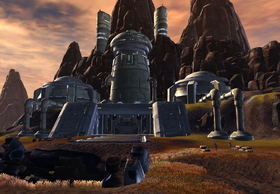
Among those calling for a repeal of the treaty was Gaul Panteer, [26] the crown prince of Alderaan, who represented his world in the Senate during the Great War. Despite Alderaan's reputation as a peaceful and unconflicted planet, its leadership became remarkably hostile towards the Sith following the Empire's invasion of their world. During the invasion, the Imperial forces took the Royal family hostage and killed many Alderaanians, but were ultimately defeated by a Republic and Jedi task force. In the aftermath of the battle, the Alderaanian Royal Family advocated for aggressive military action against the Empire, which would eventually come into direct conflict with the mandates of the treaty. Upon hearing the announcement that peace had been established with the Sith, the Crown Prince stormed out of the Senate in a rage, declaring his world an independent system. The people of Alderaan had mixed reactions to their planet's secession, leading to a political uproar that resulted in the assassination of the prince. Only days later, the Queen died heirless, leaving the future of Alderaan in doubt. Both the Republic and Empire moved to capitalize on the turmoil, leading to one of the bloodiest conflicts of the Cold War. [18]
A civil war also erupted on Ord Mantell, as a guerrilla force of separatists advocated that the planet secede from the Republic much like Alderaan and many other worlds had. Although thoroughly corrupt, Ord Mantell's government was unwaveringly loyal to the Republic and engaged the separatists in a violent struggle across their world. [19] Other planets did not choose to leave the Republic, but were forced out. The Treaty of Coruscant dictated that the Senate rescind the membership of several outlying worlds, including Bothawui and Rodia. Senator Am-Ris was saddled with the responsibility of informing these worlds of their discontinued association with the Republic; Rodian Ambassador Mareesh was so outraged by the situation that he withdrew his delegation from the Senate before Am-Ris had an opportunity to fully explain the reasons behind his acceptance of the treaty. [5]
Several flashpoints of the Great Galactic War remained openly contested following the treaty, due to Republic military commanders refusing to acknowledge the peace agreement. These conflicts included the battle on Balmorra, where General Buryn of the Republic Military failed to meet the deadline for withdrawal established in the Treaty of Coruscant. Imperial forces re-engaged his men, pushing Buryn to pursue counterattacks. [5] The general and his men were eventually pulled off the world, but the Republic left behind a small force in order to aid the Balmorran resistance. [21] On Dantooine, Major Dael and Lieutenant Harron Tavus agreed that the treaty was unlikely to stand for an extended period of time, and so continued their fight against the Empire. [5]
In response to the galactic unrest, the Republic military began recruiting highly skilled troopers from among its own ranks in order to form new squadrons of elite Republic Special Forces. These Special Forces were intended to be an advanced fighting force of shock troops that could defend the Republic in the event that the treaty broke down and the galaxy returned to war. [24] It was suspected that the Republic's renowned General Elin Garza was authorizing military strikes against Imperial targets with these troopers, but such accusations were unproven. [27]
"This is not treason, Lieutenant. Treason would be standing by while the Republic succumbs to Sith deception yet again. "
"Think about it Tavus. You know the treaty is just the Empire's way of setting us up for the killing blow. We can't allow it." ―Jedi Master Dar'Nala and Jedi Knight Fortris Gall, to Republic Lieutenant Harron Tavus [15]
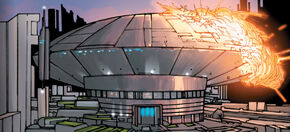
The Jedi suffered heavily during the Great War and in the aftermath of the treaty, leaving many within the Order to question their place in the Republic. In the immediate wake of the signing of the treaty, one Jedi, Master Dar'Nala, launched a personal vendetta against the peace and its architect, Lord Baras. Dar'Nala recruited other members of the Order to aid her in her campaign, including Jedi Knight Fortris Gall. Together with their co-conspirators Lieutenant Harron Tavus and the mercenary Dalborra, the two Jedi nearly restarted the Great War by orchestrating assassinations throughout the Republic and Empire and manipulating the leaders of the galactic governments into believing both sides were gearing up for renewed conflict. Although she was supported by a substantial number of officers in the Republic Military, Dar'Nala's plan was ultimately foiled by her apprentice, Satele Shan. [15]
Dar'Nala's involvement with the violence surrounding the end of the war was kept a secret, [15] but the Jedi were still punished for the events leading up to and during the Alderaan Peace Conference. The Galactic Senate placed much of the blame for the war's loss on the Jedi, as the Order had been entrusted with the protection of the Republic through the decades of the conflict. [2] That fact, in addition to the necessity to rebuild other parts of Coruscant, led to the Senate's decision to indefinitely delay the reconstruction of the Jedi Temple following its razing during the Sacking of Coruscant. [1] The members of the Order agreed that it would be best if they were to relocate their headquarters off of Coruscant, as public opinion on the world had turned heavily against them. [2] With the aid of Satele Shan, [28] the Jedi established a new temple and enclave on their ancestral homeworld of Tython, where they were able to aid the Republic while remaining independent of political maneuvering. [29] Even this action garnered criticism, however, and Republic politicians looked upon the Jedi's relocation with suspicion. [30]
Later, during the events surrounding the Xandret affair, Jedi Councilman Oric Traless informed Shigar Konshi that around one thousand young Jedi were eager to return to war with the Sith. Konshi had developed a similar outlook during his efforts on Sebaddon, and vocalized them to the Jedi Council. The elder members of the council disagreed with the call for war and discouraged Konshi from following a path that sought conflict. [16]
". never again will I stay my hand when the destruction of the Republic and the Jedi is within my reach."
"Never again will that be necessary. I assure you." ―Lords Angral and Baras [1]
Although the Treaty of Coruscant was not an unconditional surrender for the Republic, the galaxy at large understood that the Sith were resoundingly victorious in the Great War, and that the Republic was now at their mercy. The terms of the treaty were overwhelmingly biased for the benefit of the Empire, and its signing represented an apex of the power wielded by the Sith Emperor. [2] Although his Empire was stronger than ever, infighting soon set in and threatened to tear the mighty government apart. [31]
The first instance of this was the explosion of the fierce rivalry between Sith Lords Baras and Angral. As the leader of the attack on Coruscant, Angral relished the opportunity to destroy the heart of the Republic and eliminate the Jedi Order, but was prevented from doing so by Baras's treaty. Baras believed Angral to have been rash in his actions on Coruscant, as Angral's slaughter of the Supreme Chancellor nearly cost Baras his life. Following the Alderaan Peace Conference, Baras was commended by the Dark Council for his work in establishing the treaty, but Angral fostered a heavy grudge against his fellow Sith Lord. [1] Baras knew of this grudge, and so assumed that it was Angral who was inciting the violence between the Republic and Empire in the aftermath of the war. His suspicions were reinforced when an assassin attempted to kill Baras; [5] the Sith Lord believed it was Angral's sloppy attempt at removing the treaty's chief architect. Angral, meanwhile, came to believe that it was Baras's handiwork that was instigating the continuing violence, particularly after hearing a false report that the Imperial Captain Sivill had been ordered by Baras to assault the Republic transport ship the Envoy. The two Sith Lords confronted one another on Korriban, but after a brief duel they both realized that in fact Master Dar'Nala was behind the outbreak of violence. [15]
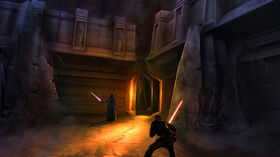
Their conflict subsided, but the Imperial infighting continued. Meanwhile, it became apparent that the Sith Emperor was no longer solely interested in total conquest, but rather a new set of personal goals. He handed control of the Empire over to the Dark Council and entrusted them with the responsibility of overseeing the day-to-day affairs of state. Their most pressing task was to consolidate the Empire's newfound power in the rapidly changing galaxy. [31]
During the Cold War, the Empire nearly negated the effects of the treaty and restarted the war during their incursion on Voss. After discovering the planet, the Empire dispatched a battle fleet to capture the world in the name of the Sith. They were opposed by the Republic, but before either force could engage one another, they were both engaged by the Voss Mystics. [20] The Empire also neglected the terms of the treaty in the Imperial Prison Break Initiative—a program they started during the Great War that was intended to break Sith prisoners out of internment within "The Tomb," the Republic's maximum-security prison on Belsavis. [32]
"Not that I give a bantha's backside what the Empire thinks. They backed out of a perfectly good war to hide behind a piece of paper." ―Roggar Den [33]
Despite being directly allied with the Empire during the Great Galactic War, the Mandalorian warrior clans experienced a fracturing in opinion after the signing of the Treaty of Coruscant. [33] [source?] Following the death of Mandalore the Lesser, Artus, his killer, rose to take the mantle of Mandalore. [9] Despite differing from his predecessor in that he was not merely a puppet of Imperial Intelligence, Artus chose to maintain the Mandalorian alliance with the Empire, albeit with more caution and sovereignty. Early in his reign, the new Mandalore was challenged by Jicoln Cadera—an upstart warrior who believed that the clans should switch allegiance and support the Galactic Republic in their ideological war with the Empire. Artus won out over Cadera's Crusader's schism, earning the title of Mandalore the Vindicated and ensuring that his people would remain in the good graces of the Sith as well-paid mercenaries. [10] However, over the next decade, Mandalorian warriors across the galaxy gradually lost respect for their Imperial employers, with some, including Roggar Den on Tatooine, citing the Treaty of Coruscant as evidence of the Empire's apparent unwillingness to continue fighting the Great War and the Sith's inability to act against the mandates of their politicians. [34]
"Peace between the Jedi and the Sith is inherently impossible. The Sith believe in violence and war, and they hate the Jedi. The Jedi thus fight the Sith to protect themselves and the galaxy. But how do the Jedi react when the Sith promise to stop fighting? They're duty-bound to 'try' to observe the peace, even though they know it's just a lie." ―Robert Chestney [35]
The Treaty of Coruscant acts as the basis for the setting of the LucasArts massively multiplayer online role-playing game Star Wars: The Old Republic. The Treaty was first mentioned in a short page reviewing the game's setting [36] on The Old Republic ' s official website, but was later greatly developed in other features of the site, particularly The Holonet—an in-universe collection of reports and stories from The Old Republic timeframe. The events surrounding the Treaty were also elaborated upon in Treaty of Coruscant, the first in a series of online video timelines on The Old Republic site. The timelines are narrated by Jedi Master Gnost-Dural, whose voice is provided by actor Lance Henriksen.
The motives and affairs of the individuals responsible for the treaty were revealed in the online comic book Star Wars: The Old Republic, Threat of Peace, written by Rob Chestney. Threat of Peace introduced the Great Galactic War and several of the characters and locations that would be featured in the game, and set the stage for the Cold War that would serve as the setting for The Old Republic. More information was provided in The Old Republic: Deceived, a 2011 novel written by Paul S. Kemp, and Star Wars: The Old Republic—The Lost Suns, the third arc in The Old Republic comic series.